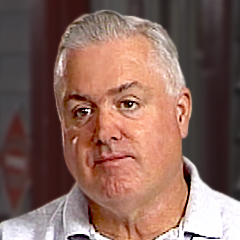
Making Rocks & Hillsides
Ray MueserIn this video, Ed Sike explains how the Western Pennsylvania Model Railroad Museum layout modelers make various parts of their scenery, specifically rocks and hillsides. In front of him is a rubber mold mounted on a wood frame for casting various sizes of rocks of varying textures. To make the mold casting, he sprays the mold with water, mixes up plaster paris, pours it in, levels it and lets it harden overnight. In the morning, he presses on the bottom of the mold and the castings pop out. The mold can make small rocks or large. The castings can then be colored to match the scenery that is trying to be replicated.
In front of Ed is a piece of ceiling tile that he will use to make the horizontal strata rock faces that are common is West Pennsylvania. He scores it with a knife and break it apart in long strips. They are then glued one on top of the other. Elmer’s glue or carpenters glue will do. After the glue is dried the front is brushed over with a wire brush to bring out the great rock appearance. The tile can be colored with a water based paint or coloring solution to match whatever rock that is trying to be replicated.
He points to an area on the layout which shows workers cleaning out a drainage ditch that will go underneath the railroad and drain into the river. The strata of the rock is relatively horizontal and it varies in color as it moves back and forth. This coloring and the drainage is typical of Western Pennsylvania so the water doesn’t weaken the roadbed. Looking at an area just west of Ekhardt Junction and Cumberland, there is a shale hill. To learn how this was created, watch the full video. To learn more about making rock molds and casting rock structures, visit the Model Railroad Academy archives.